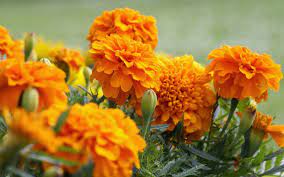5 Types of Marigolds (How to Grow Marigolds and Their Benefits)
The Marigold, also known as the Tagetes, is a beautiful small flower that grows in North America. It has many different types of flowers and can be seen blooming in both the fall and summer.
The marigold does best when planted outside but people often grow them inside containers too. The marigolds are popular because they are sturdy and bloom well even if they aren’t planted outdoors.
In this article, you will learn about some of these varieties and how to care for your own marigolds.
1. French Marigolds
The French marigolds are often planted in the spring or fall. They are often planted outdoors because they don’t do great indoors. The flowers will not bloom as long when they aren’t exposed to sunlight but it is important that they get at least six hours of bright sunlight each day
The French Marigold has a light scent and smaller petals which make them easy to grow, even for beginners.
There are also different types of French marigolds, including:
- Bonanza marigolds, which are tall and grow in bunches of 15-30 flowers.
- Janie marigolds, which tend to be planted between May and August. The plant is quite bushy and grows approximately 8 inches high with colors such as yellow, orange, and maroon.
- Little Hero marigolds, which are often planted in late spring and have a light scent.
- Bounty marigolds, which usually do best if planted in the early summer.
- Hero marigolds, which are often planted in the spring and grow to around five inches high.
- Safari marigolds, which usually do best if planted in late summer and grow to approximately nine inches high. They have colors such as yellow, orange and scarlet red.
- Summer Crystal marigolds, which are often planted between May and August. These flowers grow to approximately four inches high with light-colored petals.
French marigolds are an incredibly popular flower because they are easy to care for and grow quickly. They are often planted in the spring as a border for gardens. It’s important to keep them weeded and watered, especially after transplanting because they do not take well to changes in their environment.
Main advantages: hold up better in wet weather than many other varieties; do well with limited sunlight indoors and are great conversation starters.
2. Signet (Single) Marigolds
The single Signet marigold is often planted in the fall and can grow up to 2 feet tall. They are usually planted outdoors because they do not do well indoors or with indoor lighting. The plant needs at least six hours of sunlight each day
They are a striking flower that looks beautiful when planted together as a border but also look great by themselves.
Signet Marigolds have light tan petals surrounding their bright yellow center which makes them very special-looking flowers. The most common color is orange, but sometimes you may find some that have reds or yellows around the edges if you’re lucky!
There are also different types of signet marigolds, including:
- Lemon gem marigolds, which bloom during the summer and grow up to 12 inches high.
- Tangerine gem marigolds, which are often planted in late spring and grow up to 7 inches high.
- Red gem marigolds, which bloom during the fall and are often planted in August. The plant grows to 10-12 inches high.
- Spanish tarragon marigolds, which bloom during the summer and grow up to 14 inches high.
- Irish Lace marigolds, which bloom during the summer and grow up to 8 inches high.
Signet Marigolds are a popular flower because they come in so many different colors. They look great both inside and outside but need lots of light if you plan on having them indoors. It is important that they get at least six hours of sunlight each day or they won’t survive long.
Main advantages: grow quickly, bloom all summer long.
3. African Marigolds
African marigolds are often used in outdoor containers that can be moved indoors when necessary. The plant produces a lot of seeds but they don’t grow well in colder temperatures so it’s best to start them indoors or buy them from the store after which you can move them outdoors once the weather gets better
The African marigold doesn’t grow very tall and has petals that are usually shades of orange, red, pink, white, brown, or yellow. They also bloom during both the spring and fall seasons.
The plant grows approximately 12 inches high and blooms for several months. The African marigold is usually grown in the summer, but they will die back as soon as the fall comes along
Colors such as reds and oranges make this flower a bold addition to any garden bed or container. They can also be planted together in mass production for weddings.
Main advantages: Plant them in fall or spring, easy to grow and maintain, inexpensive, great as a border.
4. Triploid Hybrids
Triploid hybrids make up the third and final category of marigolds. The primary difference between these flowers and “normal” marigolds is that they do not release pollen into the air, so you will never have to worry about them pollinating your vegetables or being a general nuisance
The triploid hybrid marigold blooms in the summer months only. They can grow up to 1-4 feet tall but since they are sterile, it’s rare for them to produce any seed. Triploids are often planted at weddings because they come in such vibrant colors as orange, white and yellow.
After planting your seeds indoors wait until spring when the weather remains warm then move them outside where they can thrive all summer long on their own.
Main advantages: Don’t spread their pollen, high in nutrients, easy to grow and maintain, great for weddings and other events where you need a lot at once.
5. Zenith Marigolds
Zenith marigolds are quite different from the others on this list because they don’t produce many flowers or seeds. They can be used as decorative plants but it’s not recommended that you use them as food or leave them outside in your garden bed because they will die quickly due to the fact that there’s no flower or seed production with these particular marigold flowers
The zenith marigold is short-lived – lasting only about 20 days before dying – which makes them perfect for bouquets, indoor arrangements or outdoor floral installations where the flowers won’t be disturbed
As with other marigolds, these do best in full sunlight. A lot of people use them for wedding bouquets and centerpieces because they are available all year round. They don’t produce seeds but instead a large number of small blossoms that last up to 20 days before dying
Main advantages: Attractive colors and shapes, easy to grow and maintain, great for mass weddings or events.
The Advantages of Growing Marigolds
There are many advantages to growing marigolds, including the fact that they add color to most gardens. In addition, both of the species recommended for use in flowers have a reputation for being bright and cheerful as well as low-maintenance and adaptable to many different garden soils
Besides their blooms, marigolds are edible! The leaves can be used fresh or dried in salads or cooked in soups. They’re also known to repel flies, mosquitoes, and nematodes. Once you’ve grown them yourself you’ll never want to purchase grocery store produce again!
Marigold plants will grow about 13 inches tall but if you allow the ends of the plant to flow over into other areas it can take up more horizontal space, thus growing slightly taller than if it was contained within a smaller space
All varieties of marigold plants (including African, French, and dwarf varieties) require full sun to grow and bloom properly. They also need a lot of water! Make sure your soil is nice and moist before planting seeds or transplanting the plant itself into the ground. These plants will wilt in very dry weather but otherwise, they’re fairly vigorous and can withstand some neglect. You can overwater them slightly if you want; it’s better for that than too little water
How to Grow Marigolds
Regardless of which type of marigolds you want to plant, there are a few tips that apply to all of them. Keeping these tips in mind can make a significant difference in the size and color of your plants. Here are a few of those tips:
1. Marigolds love the heat
If you live in a hot climate, marigolds are going to be an excellent addition to your landscape. They grow best in warm temperatures and can even handle drought conditions better than most other flowers can
2. Protect them from cold weather
If you live in an area where winter is harsh or the temperature drops below freezing on any regular basis, you may want to consider moving your marigold plants indoors for the winter season. For some varieties of marigolds, this could actually be ideal since they don’t start producing buds until September or October when it begins to cool off at night outside
3. Start with healthy seeds or plants!
Regardless of what kind of plant you’re starting with, make sure it’s healthy before you start your growing process. Check the plants for signs of insects or disease first While it’s true there are some marigold varieties that don’t produce seeds, most will blow like crazy in the wind and they can be very difficult to control once they’re in full bloom
4. Choose your variety carefully
There are so many different types of marigolds available to plant: African, French, and dwarf varieties, and even hybrids that have been bred specifically for mass-market appeal. Before you purchase a packet of seeds or start transplanting seedlings into your garden beds, take a look at the recommendations (and tips!) we’ve outlined above. Doing this can help ensure you’re getting the right variety for you a majority of the time.
Using Marigolds for Health and Well-Being

You can research marigolds online for their health and medicinal purposes. You will find the information you were not expecting to know.
These flowers are surprisingly powerful, as they’ve been used for thousands of years to treat everything from toothaches and skin abrasions to bee stings, snake bites, and tapeworms
The most effective way to use marigold plants is fresh; dried flowers will lose their potency rather quickly so if you’re interested in using them for medicinal purposes it’s best to make an infusion or tincture right away (you can also purchase dried flowers but only keep them around for one year)
Since some people may be allergic to the oil found inside the flower itself, it’s important you do your own research before taking any medicines that contain marigold ingredients. It’s also best to consult with your doctor first before using any supplements that contain marigold.
Conclusion
Marigolds are a beautiful plant that can be used for medicinal purposes and are also great to grow in the fall or summer. They need full sun, moist soil, protection from cold weather if you live where it gets too cold during winters, and careful consideration of which variety is best for your climate zone.




















